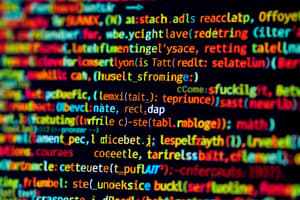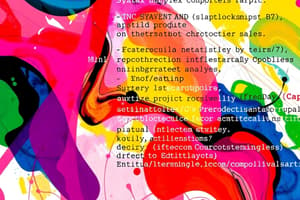Podcast
Questions and Answers
What is the low-level part of the syntax analysis portion of a language processor called?
What is the low-level part of the syntax analysis portion of a language processor called?
What is the high-level part of the syntax analysis portion of a language processor called?
What is the high-level part of the syntax analysis portion of a language processor called?
What are the advantages of using BNF to describe syntax?
What are the advantages of using BNF to describe syntax?
Why is it important to separate lexical and syntax analysis?
Why is it important to separate lexical and syntax analysis?
What is a lexical analyzer in the context of language processing?
What is a lexical analyzer in the context of language processing?
What is the purpose of a lexical analyzer?
What is the purpose of a lexical analyzer?
How are lexemes associated with lexical categories called tokens?
How are lexemes associated with lexical categories called tokens?
Which approach can be used to build a lexical analyzer?
Which approach can be used to build a lexical analyzer?
How can transitions in a state diagram be simplified?
How can transitions in a state diagram be simplified?
What is the purpose of the utility subprogram 'getChar'?
What is the purpose of the utility subprogram 'getChar'?
How are reserved words and identifiers recognized in a lexical analyzer?
How are reserved words and identifiers recognized in a lexical analyzer?
What is the purpose of the utility subprogram 'lookup'?
What is the purpose of the utility subprogram 'lookup'?
What does a state transition diagram describe?
What does a state transition diagram describe?
What is the purpose of the lexical analyzer in the context of language implementation?
What is the purpose of the lexical analyzer in the context of language implementation?
What is the purpose of a syntax analyzer (parser)?
What is the purpose of a syntax analyzer (parser)?
What is the purpose of a state diagram in the context of lexical analysis?
What is the purpose of a state diagram in the context of lexical analysis?
What is the mathematical basis for a lexical analyzer?
What is the mathematical basis for a lexical analyzer?
What is the high-level part of the syntax analysis portion of a language processor called?
What is the high-level part of the syntax analysis portion of a language processor called?
What are the advantages of using BNF to describe syntax?
What are the advantages of using BNF to describe syntax?
Why is it important to separate lexical and syntax analysis?
Why is it important to separate lexical and syntax analysis?
What is the purpose of a lexical analyzer?
What is the purpose of a lexical analyzer?
What is the mathematical basis for a lexical analyzer?
What is the mathematical basis for a lexical analyzer?
How can transitions in a state diagram be simplified?
How can transitions in a state diagram be simplified?
What is the purpose of the utility subprogram 'lookup'?
What is the purpose of the utility subprogram 'lookup'?
Which approach can be used to build a lexical analyzer?
Which approach can be used to build a lexical analyzer?
What is the role of a syntax analyzer (parser)?
What is the role of a syntax analyzer (parser)?
What does a state transition diagram describe?
What does a state transition diagram describe?
What is the low-level part of the syntax analysis portion of a language processor called?
What is the low-level part of the syntax analysis portion of a language processor called?
Why is it important to separate lexical and syntax analysis?
Why is it important to separate lexical and syntax analysis?
What are the advantages of using BNF to describe syntax?
What are the advantages of using BNF to describe syntax?
How are reserved words and identifiers recognized in a lexical analyzer?
How are reserved words and identifiers recognized in a lexical analyzer?
What is the purpose of the utility subprogram 'getChar'?
What is the purpose of the utility subprogram 'getChar'?
What is the mathematical basis for a lexical analyzer?
What is the mathematical basis for a lexical analyzer?
What is the high-level part of the syntax analysis portion of a language processor called?
What is the high-level part of the syntax analysis portion of a language processor called?
What are the advantages of using BNF to describe syntax?
What are the advantages of using BNF to describe syntax?
What is the purpose of a lexical analyzer in the context of language implementation?
What is the purpose of a lexical analyzer in the context of language implementation?
Why is it important to separate lexical and syntax analysis?
Why is it important to separate lexical and syntax analysis?
How can transitions in a state diagram be simplified?
How can transitions in a state diagram be simplified?
What is the low-level part of the syntax analysis portion of a language processor called?
What is the low-level part of the syntax analysis portion of a language processor called?
What is the purpose of a lexical analyzer?
What is the purpose of a lexical analyzer?
How are reserved words and identifiers recognized in a lexical analyzer?
How are reserved words and identifiers recognized in a lexical analyzer?
What are the three approaches to building a lexical analyzer?
What are the three approaches to building a lexical analyzer?
What is the purpose of the utility subprogram 'getChar'?
What is the purpose of the utility subprogram 'getChar'?
What does a state transition diagram describe?
What does a state transition diagram describe?
How can transitions in a state diagram be simplified?
How can transitions in a state diagram be simplified?
What is the role of a syntax analyzer (parser) in language implementation?
What is the role of a syntax analyzer (parser) in language implementation?
What is the purpose of a state diagram in the context of lexical analysis?
What is the purpose of a state diagram in the context of lexical analysis?
Flashcards are hidden until you start studying
Study Notes
Lexical and Syntax Analysis in Language Implementation Systems
- Syntax analysis in language implementation systems is based on a formal description of the syntax of the source language, typically using BNF (Backus-Naur Form).
- Syntax analysis consists of a low-level lexical analyzer, based on a finite automaton and a high-level syntax analyzer or parser, based on a push-down automaton, both derived from the BNF.
- Advantages of using BNF for syntax description include providing a clear and concise syntax description, enabling the parser to be directly based on the BNF, and making parsers based on BNF easy to maintain.
- Separating lexical and syntax analysis allows for simplicity, efficiency, and portability. It simplifies the parser, optimizes the lexical analyzer, and ensures the portability of the parser.
- A lexical analyzer is a pattern matcher for character strings and serves as a "front-end" for the parser, identifying substrings of the source program that belong together (lexemes) and associating them with a lexical category called a token.
- The lexical analyzer is usually a function called by the parser when it needs the next token, and it can be built using three approaches: formal description, state diagram design with a program, or hand-constructed table-driven implementation of the state diagram.
- State diagram design involves a directed graph with labeled nodes (state names) and arcs (input characters causing transitions), which may include actions the lexical analyzer must perform.
- In many cases, transitions in state diagrams can be combined to simplify the diagram, such as recognizing identifiers and integer literals by using character classes and transitions.
- Reserved words and identifiers can be recognized together using table lookup to determine if a possible identifier is a reserved word.
- Convenient utility subprograms such as getChar, addChar, and lookup are used in lexical analysis to handle input characters, accumulate lexemes, and determine if a string is a reserved word.
- The text provides an example of a lexical analyzer output when used on a specific input, demonstrating the identification of tokens and lexemes.
- Syntax analysis is a common part of language implementation, and a syntax analyzer (parser) detects syntax errors and produces a parse tree from the source code.
Studying That Suits You
Use AI to generate personalized quizzes and flashcards to suit your learning preferences.




